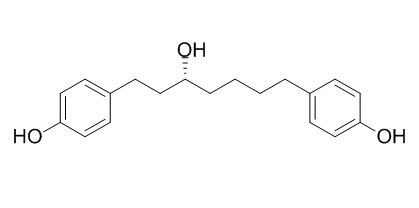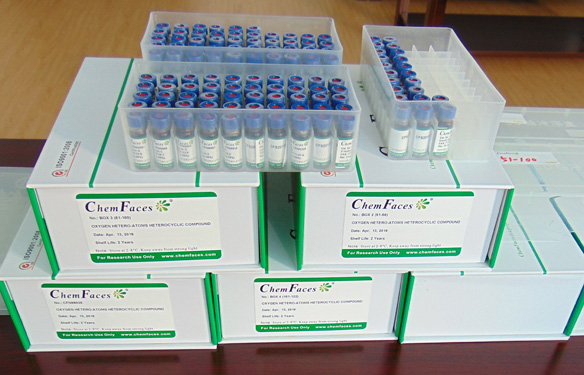Centrolobol
(-)-Centrolobol has antifibrotic activity, it can significantly inhibit the proliferation of HSC-T6 cells in a dose-dependent manner. Centrolobol exhibits strong cytotoxic activity against KB cell line.
Inquire / Order:
manager@chemfaces.com
Technical Inquiries:
service@chemfaces.com
Tel:
+86-27-84237783
Fax:
+86-27-84254680
Address:
1 Building, No. 83, CheCheng Rd., Wuhan Economic and Technological Development Zone, Wuhan, Hubei 430056, PRC
Providing storage is as stated on the product vial and the vial is kept tightly sealed, the product can be stored for up to
24 months(2-8C).
Wherever possible, you should prepare and use solutions on the same day. However, if you need to make up stock solutions in advance, we recommend that you store the solution as aliquots in tightly sealed vials at -20C. Generally, these will be useable for up to two weeks. Before use, and prior to opening the vial we recommend that you allow your product to equilibrate to room temperature for at least 1 hour.
Need more advice on solubility, usage and handling? Please email to: service@chemfaces.com
The packaging of the product may have turned upside down during transportation, resulting in the natural compounds adhering to the neck or cap of the vial. take the vial out of its packaging and gently shake to let the compounds fall to the bottom of the vial. for liquid products, centrifuge at 200-500 RPM to gather the liquid at the bottom of the vial. try to avoid loss or contamination during handling.
Food Chem.2020, 313:126079
Viruses2023, 15(6), 1377
Oncol Lett.2020, 20(4):122.
Industrial Crops and Products2024, 219:119123
Life (Basel).2021, 11(12):1399.
ACS Omega.2022, 7(44):40009-40020.
Clin Transl Med.2021, 11(5):e392.
In Vivo.2022, 36(3):1136-1143.
Biomed Pharmacother.2022, 156:113929.
International Food Research Journal2018, 25(6):2560-2571
Related and Featured Products
J Agric Food Chem. 2004 Sep 22;52(19):5869-72.
Identification of centrolobol as the platyphylloside metabolite responsible for the observed effect on in vitro digestibility of hay.[Pubmed:
15366834]
METHODS AND RESULTS:
Syntheses of the metabolites from platyphylloside, a phenol causing digestibility inhibition in rumen fluid, have been performed to identify the active metabolite. 1,7-Bis(4'-hydroxyphenyl)-3-heptanone (3-platyphyllone), racemic, and the two enantiomers of 1,7-bis(4'-hydroxyphenyl)-3-heptanol (Centrolobol) and 1,7-bis(4-hydroxyphenyl)heptane (platyphyllane) were synthesized and tested regarding digestibility inhibition in vitro in cow rumen fluid.
CONCLUSIONS:
All compounds tested induced a decreased digestion. Centrolobol was found to be the metabolite causing the observed effect, and (R)-Centrolobol was found to be the enantiomer formed in the rumen liquor in vitro.
Planta Med. 2015 Feb;81(3):222-7.
Aceroside VIII is a new natural selective HDAC6 inhibitor that synergistically enhances the anticancer activity of HDAC inhibitor in HT29 cells.[Pubmed:
25590368]
The identification of new isoform-specific histone deacetylase inhibitors is important for revealing the biological functions of individual histone deacetylase and for determining their potential use as therapeutic agents. Among the 11 zinc-dependent histone deacetylases that have been identified in humans, histone deacetylase 6 is a structurally and functionally unique enzyme.
METHODS AND RESULTS:
Here, we tested the inhibitory activity of diarylheptanoids isolated from Betula platyphylla against histone deacetylase 6. Aceroside VIII selectively inhibited histone deacetylase 6 catalytic activity and the combined treatment of aceroside VIII or (-)-Centrolobol with A452, another selective histone deacetylase 6 inhibitor, led to a synergistic increase in levels of acetylated α-tubulin. Aceroside VIII, paltyphyllone, and (-)-Centrolobol synergistically enhanced the induction of apoptosis and growth inhibition by A452. Consistent with these results, A452 in combination with aceroside VIII, paltyphyllone, or (-)-Centrolobol was more potent than either drug alone for the induction of apoptosis.
CONCLUSIONS:
Together, these findings indicate that aceroside VIII is a specific histone deacetylase 6 inhibitor and points to a mechanism by which natural histone deacetylase 6-selective inhibitors may enhance the efficacy of other histone deacetylase 6 inhibitors in colon cancer cells.
Biosci Biotechnol Biochem. 2012;76(9):1616-20.
Antifibrotic activity of diarylheptanoids from Betula platyphylla toward HSC-T6 cells.[Pubmed:
22972321 ]
METHODS AND RESULTS:
A chemical investigation of the n-butanol fraction of the inner bark of Betula platyphylla led to the isolation of seven diarylhepanoids, (-)-Centrolobol (1), aceroside VII (2), aceroside VIII (3), (3R)-1,7-bis-(4-hydroxyphenyl)-3-heptanol-3-O-[2,6-bis-O-(β-D-apiofuranosyl)-β-D-glucopyranoside (4), 1,7-bis-(4-hydroxyphenyl)-5-hepten-3-one (5), platyphyllone (6) and platyphylloside (7). The antifibrotic effects of these isolates were evaluated with HSC-T6 cells by assessing cell proliferation. Among them, compounds 1, 2, 5 and 6 significantly inhibited the proliferation of HSCs in a dose-dependent manner at concentrations from 10 μM to 100 μM. Compound 5 in particular dramatically decreased the collagen content and increased the Caspase-3/7 activity.
CONCLUSIONS:
Taken together, the antifibrotic activity of B. platyphylla and its constituents might suggest therapeutic potential against liver fibrosis.
Records of Natural Products, 2014, 8(1):46-50.
Cytotoxic Sesquiterpenoids and Diarylheptanoids from the Rhizomes of Curcuma elata Roxb.[Reference:
WebLink]
METHODS AND RESULTS:
The present study was aimed to investigate the chemical constituents of Curcuma elata Roxb. (Zingiberaceae) rhizomes originating in Thailand. Ten sesquiterpenes, germacrone (1), curzerenone (2), isofuranodienone (3), furanodienone (4), curdione (5), neocurdione (6), zederone (7), curcumenone (8), 13-hydroxygermacrone (9) and zedoarondiol (10), and four diarylheptanoids, 3-hydroxy-5-platyphyllone (11), (3S)-1,7-bis(4-hydroxyphenyl)-(6E)-6-hepten-3-ol (12), Centrolobol (13) and (3S)-1-(3,4-dihydroxyphenyl)-7-(4-hydroxyphenyl)-(6E)-6-hepten-3-ol (14) were isolated for the first time from the rhizomes of this plant. The structures of the isolated compounds were identified by comparison of the spectroscopic and physical data with those of the reported values and the stereochemistry at the asymmetric carbon was determined by the modified Mosher's method and, in some cases, was confirmed by comparison of optical rotation data with literature.
CONCLUSIONS:
Compounds 12 and 13 exhibited strong cytotoxic activity against KB cell line, whereas compounds 4, 9 and 12-14 showed strong cytoxicity against NCI-H187 cell line.



